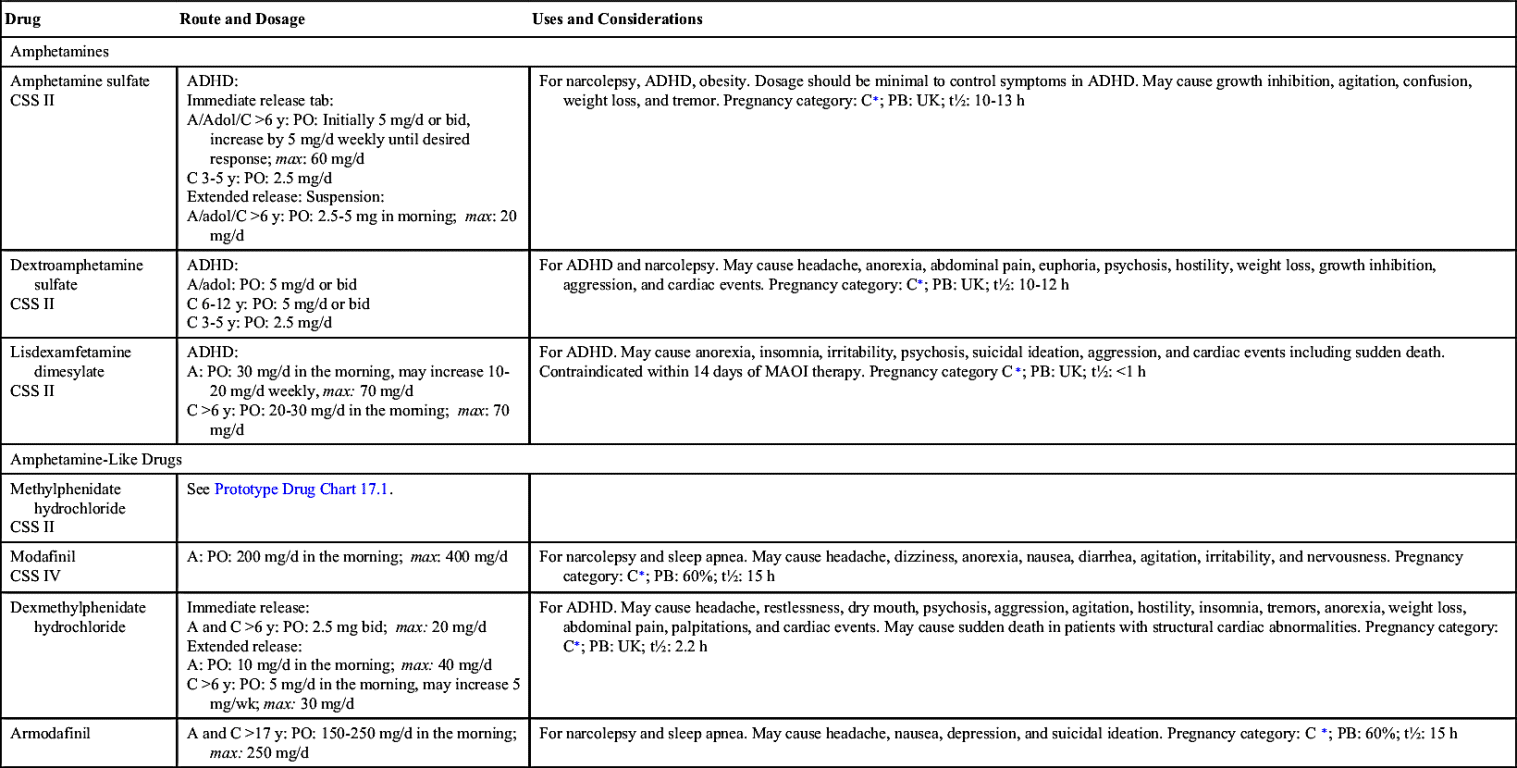http://evolve.elsevier.com/McCuistion/pharmacology
Numerous drugs can stimulate the central nervous system (CNS), which involves the brain and spinal cord and regulates body functions. Medically approved use of CNS stimulants is limited to the treatment of attention-deficit/hyperactivity disorder in children, narcolepsy, and the reversal of respiratory distress. The major groups of CNS stimulants include amphetamines and caffeine, which stimulate the cerebral cortex of the brain; analeptics and caffeine, which act on the brainstem and medulla to stimulate respiration; and anorexiants such as diethylpropion, which are thought to suppress appetite by stimulating the satiety center in the hypothalamic and limbic areas of the brain. Amphetamines and related anorexiants are greatly abused. Long-term use of amphetamines can produce psychological dependence or tolerance, conditions in which larger and larger doses of a drug are needed to reproduce the initial response. These medications are recommended for short-term use only (up to 12 weeks). Gradually increasing a drug dose and then abruptly stopping the drug may result in depression and withdrawal symptoms.
Pathophysiology
Attention-deficit/hyperactivity disorder (ADHD) might be caused by a dysregulation of the transmitter’s serotonin, norepinephrine, and dopamine. ADHD occurs primarily in children, usually before the age of 7 years, and may continue through the teenage years. In some cases, it may not be identified until early adulthood. The incidence of ADHD is three to seven times more common in boys than in girls. Characteristic behaviors of the various types of ADHD include inattentiveness, inability to concentrate, restlessness (fidgety), hyperactivity (excessive and purposeless activity), inability to complete tasks, and impulsivity.
The child with ADHD may display poor coordination, and there may be abnormal electroencephalograph (EEG) findings. Intelligence is usually not affected, but learning disabilities are often present. This disorder has also been called minimal brain dysfunction, hyperactivity in children, hyperkinesis, and hyperkinetic syndrome with learning disorder. Some professionals state that ADHD is often incorrectly diagnosed and results in many children receiving unnecessary treatment for months or years.
Narcolepsy is characterized by falling asleep during normal waking activities, such as driving a car or talking with someone. Sleep paralysis, the condition of muscle paralysis that is normal during sleep, usually accompanies narcolepsy and affects the voluntary muscles. The narcoleptic is unable to move and may collapse.
Amphetamines
Amphetamines stimulate the release of the neurotransmitters norepinephrine and dopamine from the brain and sympathetic nervous system (peripheral nerve terminals) and inhibit the reuptake of these transmitters. Amphetamines ordinarily cause euphoria and increased alertness, but they can also cause insomnia, restlessness, tremors, irritability, and weight loss. Cardiovascular problems such as increased heart rate, palpitations, cardiac dysrhythmia, and increased blood pressure can result from cardiac stimulation and vasoconstriction with continuous use of amphetamines. These drugs have a high potential for abuse, tolerance, and dependence. Excessive use may lead to psychosis.
The half-life of amphetamines varies from 9 to 13 hours. Amphetamines and dextroamphetamine are prescribed for narcolepsy and ADHD when amphetamine-like drugs are ineffective.
Side Effects and Adverse Reactions
Amphetamines can cause adverse effects in the CNS and the cardiovascular, gastrointestinal (GI), and endocrine systems. Side effects and adverse reactions include dizziness, headache, euphoria, confusion, blurred vision, restlessness, insomnia, tachycardia, hypertension, heart palpitations, dysrhythmias, dry mouth, anorexia, weight loss, diarrhea, constipation, seizures, tremors, and erectile dysfunction.
Amphetamine-Like Drugs for Attention-Deficit/Hyperactivity Disorder and Narcolepsy
Methylphenidate and dexmethylphenidate, classed as amphetamine-like drugs, are given to increase a child’s attention span and cognitive performance (e.g., memory, reading) and to decrease impulsiveness, hyperactivity, and restlessness. Methylphenidate is also used to treat narcolepsy. Because of the potential for abuse of methylphenidate, it is classified as a Controlled Substance Schedule (CSS) II drug. Prototype Drug Chart 17.1 illustrates the pharmacokinetics, pharmacodynamics, and therapeutic effects of methylphenidate in the treatment of ADHD and narcolepsy. Amphetamine and amphetamine-like drugs should not be taken in the evening or before bedtime because insomnia may result.
Stay updated, free articles. Join our Telegram channel

Full access? Get Clinical Tree






